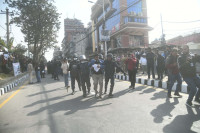Opinion
Art and the city
Demolition of traditional structures in Kathmandu in the name of urban planning will be tantamount to cultural suicide
Devendra Nath Gongal
In the 50s, I created an image of Kathmandu from the information gathered through available literature and the senior district folks returning from Kathmandu, mesmerised by the beauty of the valley settlements. The ambience of the dense clusters of residential buildings, the temples, the residential squares organically embedded with the surroundings, and the many festivals were unique and fabulous experiences of the cultural legacy of Kathmandu. But they also expressed their frustration about the narrow lanes, the dilapidating buildings, the series of maze like residential squares full of filth, and wished an earthquake (in lighter vein) destroyed everything to make way for a new and modern Kathmandu. For some, the monstrous debacle of April 25 and May 12 is providing an opportunity to create a new Kathmandu Valley in tandem with the slogan of ‘New Nepal’. Some politicians and urban planners are prodding city authorities to demolish Kathmandu’s core areas and construct a modern metropolis. Others are encouraging authorities to demolish what has remained of the urban architectural ensemble which represents the cultural legacy of Nepal. The Kathmandu Metropolitan City (KMC) is also preparing an urban house-pooling project to build a new Kathmandu. If this happens, it will be the first ever incident of its kind in human history, where cultural heritages are deliberately demolished in the name of modernisation.
Urban planning
The planning of Kathmandu is not just a technical matter, but an artistic and a cultural endeavour as well. The urban house-pooling approach is a hybrid form of land pooling. Kathmandu Valley is not an ordinary place. It is an inimitable treasure of Himalayan art and architecture. Despite its remoteness, a unique cultural tradition developed in this secluded location of the subcontinent with distinctive architecture and urban fabric.
For the planners in Nepal, land pooling has been a panacea for all planning issues. This is a planning tool applied for agriculture land readjustment in Japan, Taiwan, and Korea. In land readjustment, the land parcels get the simplest geometrical shapes that simplify irrigation systems and boost productivity.
The proposed urban house-pooling is a tool generally used by corporate business houses that buy and demolish old neighbourhoods to construct new building blocks for profit. However, in urban house-pooling, the land and building rights are surrendered but are not sold. In principle, the beneficiaries of the development projects will be the original house owners. The KMC is assuring that people that this project will have buildings with traditional facades, wide roads, residential courtyards, and temples. It sounds so sweet to the ears, but to quote Henry Kissinger, “theoretical preconceptions do not necessarily provide practical remedies”.
Culture-quake
Let us try to apprehend the legacy of Kathmandu’s core that some planners want to eradicate forever. Material heritages in the Valley developed with symbiotic cohesion with immaterial parts of human development. The significance of the buildings here is attached to the environment that they are in, and that they create. Second, buildings are not interpreted with their material parts but the ambience that they create with the life in and around it. Third, settlements are not a compilation of physical entities, but the social cohesion they create and the culture they sustain. The basic ingredients of Kathmandu’s culture are the inherited architectural legacies and the ethos that made it possible. A prominent Nepali architect, Biresh Shah, considers the urban legacy of Kathmandu as a “marvellous achievement” of Nepalis.
So, the demolition of the traditional structures will be a culture-quake after the infamous earthquake, tantamount to cultural suicide. It is not convincing that the legacy that was created over hundreds or thousands of years ago can be challenged or recreated within a decade or so by using urban house-pooling. Even a meticulously developed Las Vegas type of Kathmandu will be a far bigger predicament than the present problem.
In Kathmandu, we have experienced the mitigation of the infamous foul smell that was quite prevalent in the olden days; better drainage and healthier water systems, and cleaner courtyards in the city’s core maintain its traditional character. This proves that the regeneration and revitalisation of urban cultural heritage can be achieved through sincere efforts. Moreover, many individuals and communities have embraced the modern ways of life while preserving their traditional characteristics. Restaurants, lodges and houses with modern amenities are springing inside such neighbourhoods through local efforts.
Inimitable charm
The communities in the core areas are undergoing an implosion caused by decades of negligence which have sapped their spirits. The recent earthquake has provided an opportunity to strengthen these communities and preserve their cultural legacies without manipulating their weaknesses and financial constraints.
As Lloyd Grossman says, “Our heritage needs to be supported, protected and regulated not because it is a problem, but because it is of such immense value.” The best option would, thus, be for the government to provide sufficient funds while the planners and the municipality extend their support to the inhabitants with heritage awareness programmes and concrete actions that balances preservation with modernisation. Separating groups of vulnerable houses and rejuvenating them will ameliorate the city’s core without any morphological upheaval.
Using urban house pooling for expediency will could have culturally irretrievable consequences. To quote Gerard Toffin, “If Nepalis are not careful, Kathmandu Valley is likely to lose its links to the past and its inimitable charm.”
Gongal is ex-chairperson of Society of Nepalese Architects (Sona)




 8.12°C Kathmandu
8.12°C Kathmandu










